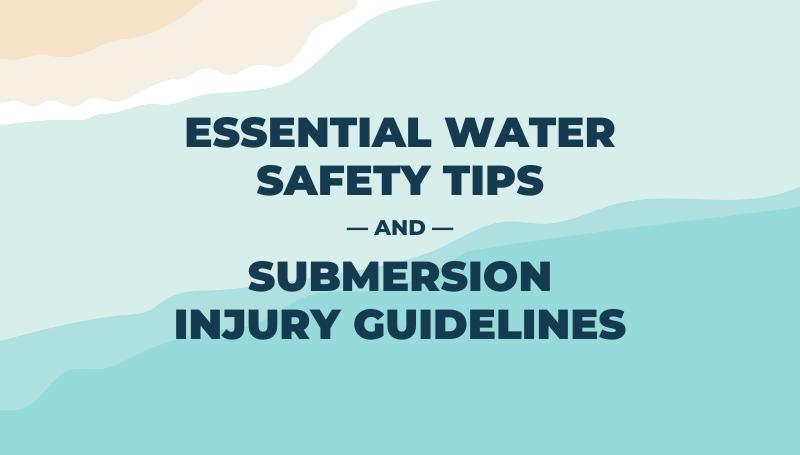The Complete Guide to Drowning Prevention and Submersion Injuries for Pediatricians
Written by Maddy Crouch

As we approach the summer months, the allure of water activities increases significantly, heightening the risk of drowning and submersion injuries among children. As pediatricians, it's crucial to discuss water safety proactively with parents to ensure they are well-informed and prepared to prevent these life-threatening incidents.
Drowning remains one of the leading causes of unintentional injury-related death among children aged 1-4 years and the second leading cause in children aged 5-14 years. Submersion injuries can lead to long-term neurological damage when they are not fatal. Pediatricians play a pivotal role in educating families about these risks and preventive measures.
Here’s what you should remind parents about water safety, plus guidelines on submersion injuries from our Pediatrics Core.
Counsel parents on how they can keep kids safe near water
Parents’ goal for drowning safety should be on prevention. The main way to prevent any accidental drowning is to prevent it in the first place, by closely supervising children near any type of body of water.
The AAP recommendations for drowning prevention include assessing all children for drowning risk on the basis of risk and age, and prioritize evidence-based strategies such as barriers, supervision, swim lessons, life jackets, and CPR.
1. Remind parents that supervision is key
Constant, attentive supervision is the cornerstone of drowning prevention. Remind parents that a child near water should always be within arm's reach of a responsible adult. Encourage parents to designate a "water watcher" whose sole responsibility is to watch the children without distractions like reading, texting, or chatting.
2. Encourage parents to teach swimming early
Encourage families to enroll their children in age-appropriate swimming lessons—even as early as one year old. Discuss the emotional readiness of the child with parents, stressing that lessons alone are not enough to make a child competent in the water.
3. Urge parents to use a life jacket
In natural water settings such as lakes, rivers, and oceans, life jackets are a must. Even for pool settings, weaker swimmers or very young children should wear life jackets. Discuss with parents the importance of using U.S. Coast Guard-approved life jackets.
4. Recommend that parents learn CPR
Encourage parents and caregivers to learn safe rescue and CPR. As pediatricians, we can provide resources or direct them to local courses. Quick action in the event of an emergency can save lives.
What to remember about submersion injury
Despite the best preventive measures, submersion incidents can still occur. Here’s what you need to remember when you see a submersion injury this summer—or if you see a question about submersion injury on the boards.
Before we go into the Submersion Injury topic excerpted from the MedStudy Pediatrics Core, let's quickly test your knowledge of submersion injury by going through a couple of Qbank+ questions on the topic.
Did you answer the questions correctly? Did anything trip you up? Review the latest guidelines on submersion injury below. The Preview | Review Question tells you what's most likely to be tested on the boards. The answer can be found highlighted below, just like in our Pediatrics Core.
The content below is excerpted from the 11th Edition Pediatrics Core > Emergency Medicine and Maltreatment > Submersion Injury. This MedStudy Core content was medically reviewed by Victoria W. Ovalle, MD, MEd.

Drowning is characterized by respiratory impairment that results from submersion/immersion in liquid and ranks 2nd to motor vehicles as a cause of accidental pediatric death. The peak risk groups for drowning include children< 5 years of age and males 15–25 years old. Young children can drown in swimming pools, bathtubs, toilets, and even small containers such as buckets. Drowning is sometimes due to child maltreatment. Submersion-related deaths in adolescents are often linked to risk-taking behaviors and alcohol consumption.
“Drowning” implies respiratory impairment either when the patient is submerged (the airway is below the surface of the liquid) or immersed (water splashes over the face). “Rescue” means that the process of drowning was interrupted, and thus the patient had a nonfatal drowning. Fatal drownings result in immediate or delayed death. The terms “near drowning,” “dry drowning,” and “wet drowning” are no longer used.
The sequence of events in the drowning patient lasts for no more than a few minutes and are as follows:
-
-
- Initially, water entering the mouth/nose is spat out.
- Conscious breath holding (~ 60 seconds) occurs.
- The inspiratory drive becomes too hard to resist, and either water is aspirated into the airways or laryngospasm occurs, preventing this aspiration.
- Cerebral hypoxia terminates the laryngospasm response.
- Hypoxia and acidosis lead to bradycardia, pulseless electrical activity (PEA), and—ultimately—asystole, as well as hypoxic-ischemic neurologic injury.
-
In patients who survive the initial insult, ARDS or acute lung injury (ALI) can result from water in the alveoli washing out surfactant. Cerebral edema resulting from hypoxia is the most frequent cause of death, and many survivors have persistent neurologic deficits. Metabolic and respiratory acidosis are both seen. Electrolyte abnormalities, such as hyponatremia, are uncommon. Although one must consider cervical spine injuries in drowning victims, most of these are evident from the clinical scenario (e.g., diving into shallow water). Neurologic status is predictive of outcome. Children who are responsive at the scene and those who arrive to the emergency department awake and responsive generally do well; children with no spontaneous movements by 24 hours are likely to die or suffer severe neurologic impairment. Submersion of > 10 minutes is classically associated with a poor prognosis. Delayed initiation of resuscitation (> 10 minutes) and asystole upon arrival to the emergency department are associated with poor neurologic outcomes.
Occasionally, hypothermic drowning victims have preserved neurologic function despite prolonged submersion. Hypothermia is thought to be protective only if the patient becomes hypothermic at the time of submersion and if rapid cooling occurs in water < 5.0°C (41.0°F); e.g., fell through ice into the water.
Freshwater and saltwater drownings are managed the same way. On the scene, ventilation is the most important intervention, followed by chest compressions if pulseless. Hospital measures include ABCs, with ventilatory support for significant respiratory distress/failure. Protect the spine as appropriate (e.g., abuse, diving injury). Vomiting is typical; place a nasogastric tube once the airway is protected. Administer supplemental oxygen as needed and order a CXR. Check blood glucose and electrolytes; metabolic and respiratory acidosis are common. After cold water submersion, warm the patient. Warm mildly hypothermic patients with external methods (e.g., removal of wet clothes, warm packs, blankets). Treat more severe hypothermia with internal techniques such as warmed IVFs, body cavity lavage (i.e., gastric, pleural, peritoneal, bladder), or ECMO if available. For drownings in freezing water, continue resuscitative efforts until the core temperature is 32.0–35.0°C (89.6–95.0°F). Remember: “not dead until warm and dead.”
Observe asymptomatic children for ~ 6 hours; if the CXR is normal and no symptoms develop, discharge. Admit all patients who are symptomatic after drowning; some with mild symptoms will worsen over the first 24 hours.
As pediatricians, your role extends beyond medical care—you are also an educator and advocate for child safety. With the arrival of summer and its associated water-related activities, it becomes even more crucial to focus on drowning prevention and the management of submersion injuries. You can use your patient interactions to counsel parents on the critical importance of water supervision, early swimming lessons, life jacket usage, and CPR training. Your proactive approach can significantly reduce the risk of drowning and ensure that children enjoy a safe summer by the water. Every conversation you have with a parent is an opportunity to save a life.


